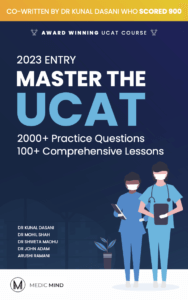The Decision Making UCAT section is the newest part. It was introduced in 2017 to replace an old similarly named section, Decision Analysis. The skills tested in this examination are mostly the same. However, the question format and time allowed for this section have changed. In order to ace this portion and succeed on the UCAT, this post will describe 10 crucial UCAT decision making tips for doing so.
How to Improve Decision Making UCAT
1. Having a technique for the Decision Making section is key
The question format for Decision Making questions might appear complicated. However, you can learn how to get better at decision making UCAT questions. For example, you may break the section down into something that is more manageable by methodically applying particular strategies to each type of question. There are many various question types in Decision Making, including syllogisms, probability, and Venn diagram questions. When doing practice questions for this section, you should categorise the questions into different question types. Make sure you have a solid strategy for each of these question categories so that you can follow a predetermined process.
Syllogism questions, for instance, may initially appear to be a jumble of confusing words. To visualise the claims and create a clear diagram from which you can confidently choose the right response, we advise utilising the Venn diagram approach. This means to set out clear groups that each item in the question falls under and draw out the corresponding Venn diagram to clearly identify where each item would lie in. An example of an application of this method is in the image below.

2. Categorise Decision Making questions into its different question types and master them accordingly
This UCAT part has six distinct types of questions. One of our crucial decision making UCAT tips is that you have practised each type extensively. Each question type includes unique strategies and time-management advice associated with it. In order to master each question type, you need to try some practice questions for each type and form your own strategy for tackling them.
Despite being one of the sections with the least amount of time restrictions, time management is still crucial in how to improve in decision making UCAT questions! There is a tendency for some question types to take longer than others. By working through each question several times, you will have a sense of how much time to allocate to each category in order to finish the section quickly.
Question Types
| Question Type | Requirements |
| Syllogisms | You are given two or more statements and have to use logical reasoning to decide what conclusions follow. You will be given 5 conclusions to evaluate. |
| Venn Diagrams | You may be presented with a set of statements or a set of different Venn diagrams as response options. |
| Probabilistic Reasoning | Select the best possible response for a question relating to probability. |
| Logical Puzzles | You would be given a series of statements and facts and you will need to infer information from them. |
| Interpreting Information | You are required to find which conclusion best follows an argument. |
| Recognising Assumptions | This test your ability to evaluate how strong an argument is in support for or against a solution to a particular problem. |
Additionally, when looking at how to improve UCAT decision making strategies, this would help you ensure that there would not be any surprises on exam day. You should also set aside extra time to practice a certain question type if you find it to be difficult for you. In the case that you are particularly struggling with a particular question type, you could even find that you might use some external help. If so, our one-on-one UCAT tutors can provide targeted assistance.
3. Make note of your mistakes
When practising UCAT Decision Making questions, another crucial decision making UCAT tips is to make sure to compile a list of all the different question types that you encounter. This would ensure that you have practised an adequate amount for each type of question. It can also help you keep track of how many times you make mistakes on each sort of question. This will allow you to understand which question type is your weakest.
UCAT Decision Making comprises a lot of question types. Thus, using this method to start organising your revision can help you pinpoint and concentrate on your weakest regions. Do not ignore the questions that you find particularly challenging. Instead, this is where you should focus your improvement efforts.
Note down the questions that you have answered incorrectly. You should also take extra care to review the questions that you have answered incorrectly. It is quite simple to just glance at the correct answer and think that the answer is obvious or that you would have gotten it correct if you tried it again. Instead, try to fully understand why your initial reasoning is incorrect. Think about how you could have arrived at the correct response. Also take the time to explore alternative solutions and their methods.

4. Practice Venn diagrams
Being able to understand and use Venn diagrams in UCAT Decision Making is crucial. Both the syllogism and Venn diagram question types depend on them. Hence, you need to be used to how they work and ensure that you can comfortably apply them to these two different question kinds. You can familiarise yourself with them by practising sketching them out if they are not in the question.
Even though this method would initially take a bit of time during the actual examination, it could ultimately help improve your speed because it can help you draw conclusions about the syllogism statements swiftly and precisely. You should keep an eye on the time while you practice. This is because understanding roughly how long it will take you to complete each question would ensure that you do not run out of time.
5. Avoid making assumptions
When analyzing information-based questions, you should avoid drawing conclusions or filling in the gaps with your own prior knowledge. It is important to ensure that your conclusion is solely based on the information the text has provided, and not on your own assumptions. For example, do not include something in your final conclusion if it is not specifically stated in the text given!
6. Read the question slowly
Although skim reading would definitely aid you in other UCAT sections, you should refrain from only focusing on the keywords and skim-reading the remaining questions for this section. Instead, take your time to make sure you choose the correct answer. This is because decision-making questions frequently include terms like “must” and “or.” If you read too quickly, you could miss these words.
7. Organise your thoughts on paper
You will frequently be given a lot of information in decision-making questions, such as information on names, colors, and locations. It can be quite overwhelming to try to organize all of this information in your head, and doing so might make it easy to forget important details. In order to guarantee that you arrive at the correct solution, you should organize your thoughts on paper. You also have sufficient time in this section to do so, so you should make use of that! Be careful to precisely outline your thought process so that you can follow it, especially when you are re-looking at it when you are checking your work.
8. Ensure that you are strict with timing
In order to complete this entire section, you must be able to answer all the questions at a rate of around one per minute. Although this may appear generous in comparison to the other sections, it is incredibly easy to become sucked into a question. You should keep an eye on the clock while answering the questions as you have 29 questions to address in 31 minutes.

Some of the questions are interesting and trying to figure your way through the problems can be quite satisfying. However, you should be careful when doing so because this might result in you spending too much time on one question, and preventing you from completing all the questions. In fact, some of the logical puzzles are intentionally too difficult to solve within the given time limit! This is done on purpose to penalise students who spend more time trying to solve the complete puzzle, even after they have worked out the correct answer to the statement. Not only that, using 5 minutes to answer 5 questions that you can easily do is more worthwhile than using that same 5 minutes to answer only one question! So overall, it is critical to be strict with yourself during this section.
9. Spatial equations
Another question type that you can streamline is the spatial equation type of questions. You can think about using some of the elementary algebraic operations you have learnt in secondary school. How might you apply them to work out some unknown values in the statements? The time saved on this sort of question can then be applied to some of the more difficult and time-consuming ones.

10. Try not to flag out too many questions
It is crucial to move on when you are stuck to avoid becoming stuck on difficult questions. It is also important to not leave any questions unanswered when you flag them. There is no penalty for guessing on the UCAT as they do not practise negative marking. Therefore, there is no harm in guessing if you do not know the answer.
In contrast to the Verbal Reasoning section where the same material or information is to be used to answer a range of multiple-choice questions, the Decision Making section only gives one set of information per question. If you flag too many questions, you may waste more time rereading the question after completing all the other questions. Hence, you should still try to provide an answer to the question while you are reading it instead of moving on completely.
FAQs
How does UCAT score Decision Making?
Any Decision Making questions with multiple parts can be awarded full marks for a complete set of correct answers or partial marks for answers that make only a single mistake. For example, if there is a Syllogism question that requires students to answer 5 statements, only students who accurately answered 4 out of 5 statements will only receive partial marks. Your total raw score will be converted to a scaled score between 300 and 900, with 900 being the best possible score and 300 being the lowest.
How long do I have for the UCAT Decision Making section?
You have 32 minutes to answer 29 questions in the Decision Making section of the UCAT. Hence, this means that you only get a little over a minute to respond to each question.
How can I improve my UCAT Decision Making score?
The greatest advice for the UCAT Decision Making section is to become familiar with all types of questions. You may find some of the questions in this section to be more difficult than others, because it has the widest range of possible questions. That being said, you should not neglect any type of question that they can ask! For example, syllogism questions should not be disregarded just because you think Venn diagram questions to be more challenging.



